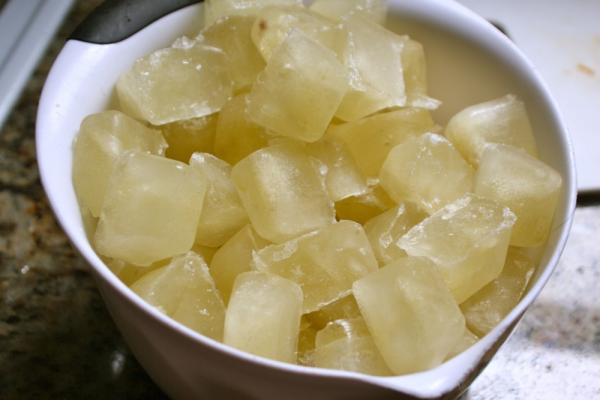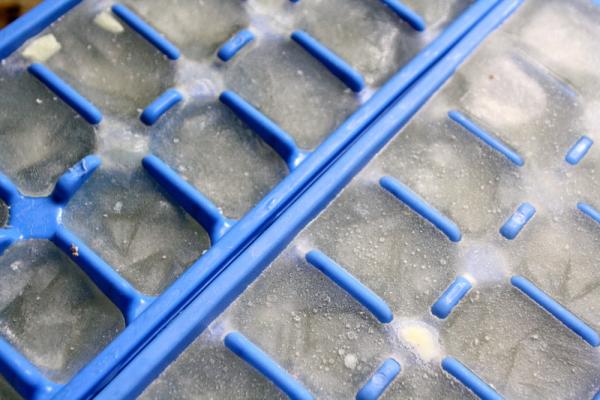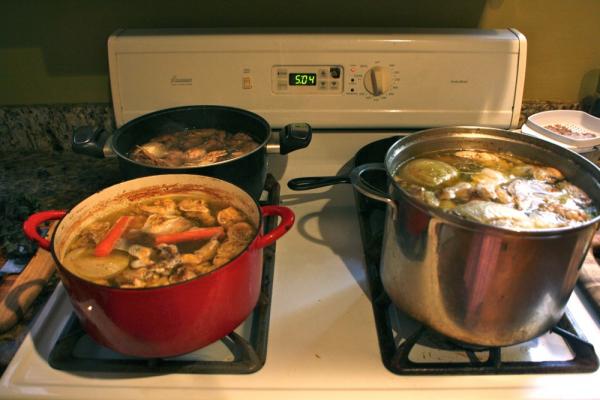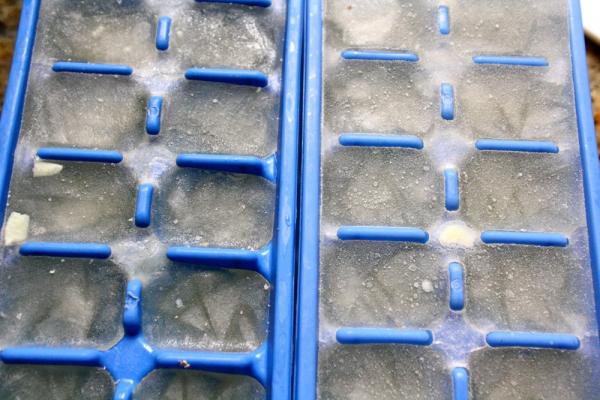Weekend Project: Freeze Chicken Stock in Ice Cube Trays
The Paupered Chef officially endorses the convenient practice.

I, Nick Kindelsperger, wholeheartedly endorse the practice of freezing chicken stock in ice cube trays. Doing so allows one to crack them into zip-lock bags and stash them in the freezer for safe keeping. It is convenient, fairly easy to do, and downright practical (in a slightly embarrassing way). Of course, the problem with dishing out little kitchen tips and tricks like this one is that there are enough of them to make even the most organized person confused. I'm as guilty as anyone. So, I decided to wait on this one just to make sure that I actually followed through, used it all, and then did it again. It passed the test.
I've long been freezing stock. I learned early on that freezing the whole batch in one bag was the wrong way to go, because it is hard to dethaw a huge hunk of ice. So, I started freezing stock in four-cup batches, thinking that would be a normal amount to use for a recipe. That is almost never the case. Nine times out of ten, recipes call for ½ cup or less, meaning I had to partially dethaw the bags, pour off the amount I need, and then refreeze them. The process was annoying and, at least whenever I tried to do it, messy.

This is the opposite. Just pull out as many little cubes as needed, zip it back up, and place the bag back in the freezer. I'm not sure if there happens to be some universal ice cube tray size, but I have three different kinds of trays, and they all measured out to about one ounce per cube. Often I just defrost them in the microwave right before I need them.
That's it! Anyone else tried this?
Chicken Stock

What kind of stock you decide to make is up to you. Blake and I have written about a number of different versions, including this handy pressure cooker one . But for this batch I just wanted a stripped down version. Naturally, I decided to go with a recipe from Ferran Adrià— the same man behind El Bulli , which is one of the most acclaimed and gastronomically adventurous restaurants in human history.
Luckily, his latest cookbook, _ The Family Meal _ , is a chronicle of the humble staff meals from the restaurant. The recipes are remarkably straightforward — undoubtedly a product of needing to feed a large group of people quickly and cheaply — but they are also well thought out and delicious. This recipe for chicken stock couldn't be any simpler, but it's the kind of simple base that is always great to have around.
Makes 8 ½ cups, though, as you can see above, I tripled it.
- 1 small onion, cut in half
- 1 carrot, cut in half crosswise
- 1 celery stalk, trimmed and cut in half crosswise
- 2 ¾ pounds raw chicken carcasses (backs and wings are good for this)
- 1 ⅓ gallons water
Combine all the ingredients in a very large pot. Turn heat to high to bring water to a boil. While the water is warming up, skim off any foam that comes to the surface. When just starting to boil, reduce heat to a keep liquid at a simmer. Let the stock cook for 2 ½ hours. Occasionally, skim off any foam that rises to the surface.
When done, set a colander over a very large bowl. Pour the stock in to the bowl, and discard all the chicken and vegetables pieces caught in the colander. Then strain the the stock through a fine-mesh sieve.
Chicken Stock Ice Cubes

If you're like me and used backs and wings, the stock will be fatty. (If not, then you can skip this step.) Let the stock cool to room temperature, which takes a while. One way to speed up the process is to wash out the large pot, and then pour the strained stock back in. Plug the sink, and then fill it about halfway up with water. Place the pot in, making sure it doesn't tip over. This should help speed up the process. Also, you can add ice cubes or ice packs to the water to cool it down even more.
Once at room temperature, cover the stock and place in the fridge over night. In the morning, some of the fat should have risen to the top. Just spoon it off and use for some other delicious project.
Use a ladle to pour the stock into the ice cube trays. Because I tripled this recipe, I didn't have enough trays, so I had to do this in batches. Place the trays in the freezer and wait until they are completely frozen. This will take multiple hours.

When ready, crack the ice cubes into a large bowl, and then transfer to a zip-lock bags. Each ice cube equals about one ounce of liquid. If they seem to stick together, carefully toss the bags on the counter — they should easily break back into individual cubes.
Food, DIY, Soup-Stew, Chicken, Cube, Environmental Issue, Ferran Adri, Ice, Ice cube, Mathematics, microwave, Nick Kindelsperger, Optical materials, Refrigerator, Stock, Water ice

Comments:
Blog Comments powered by Disqus.